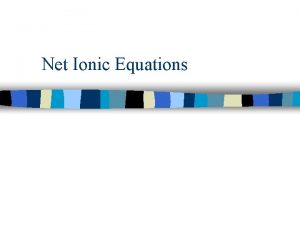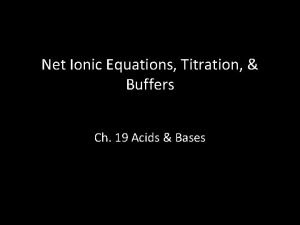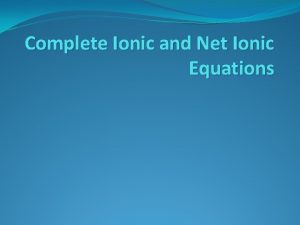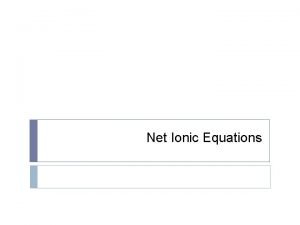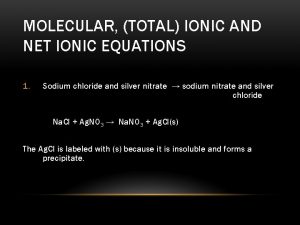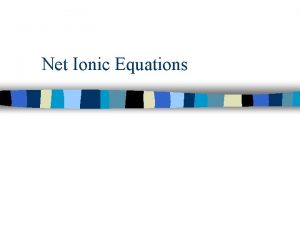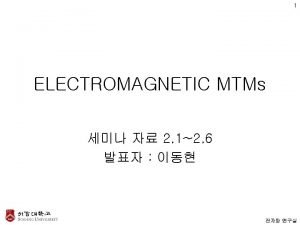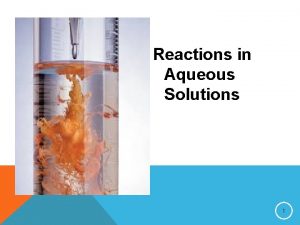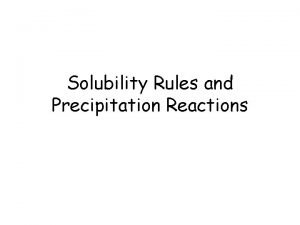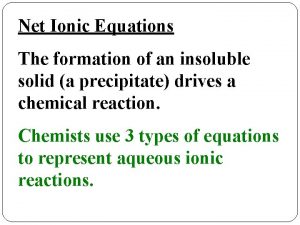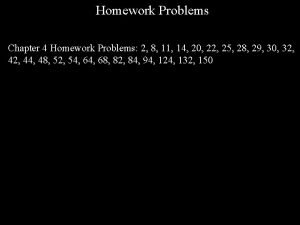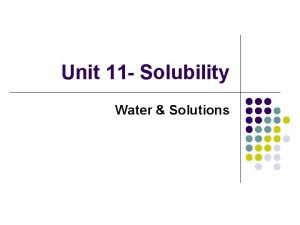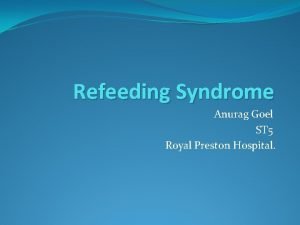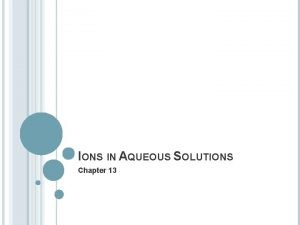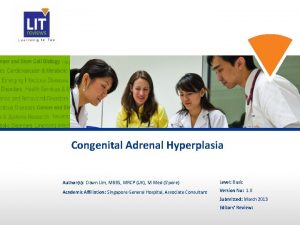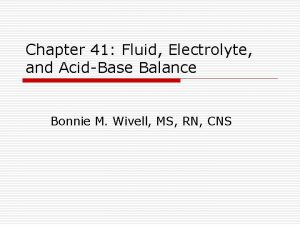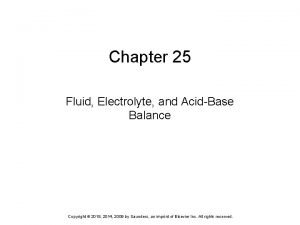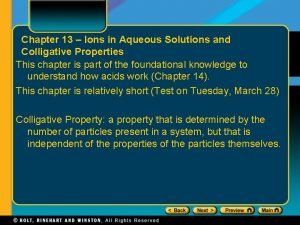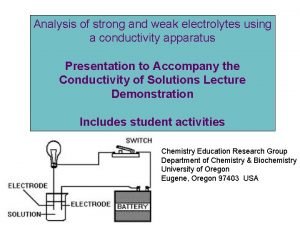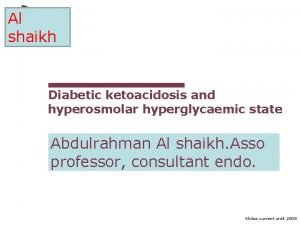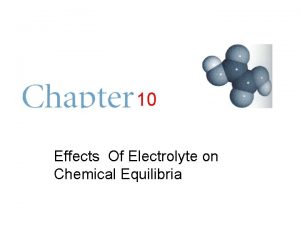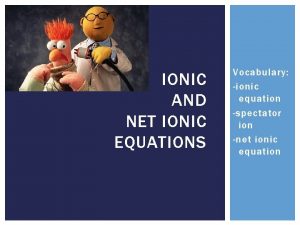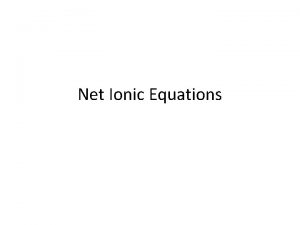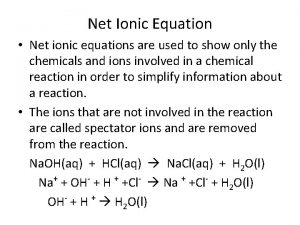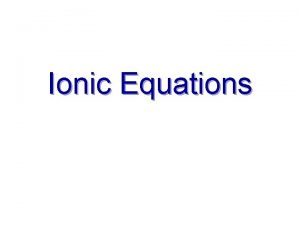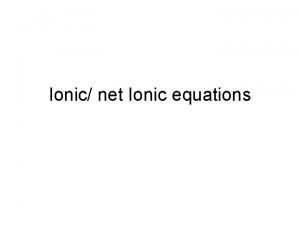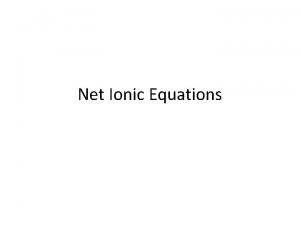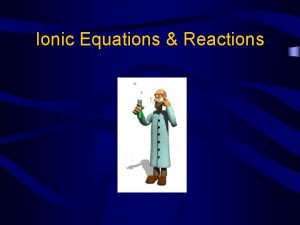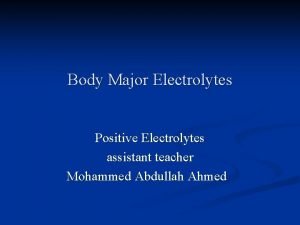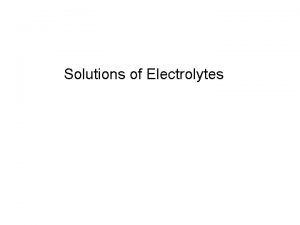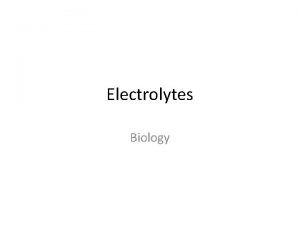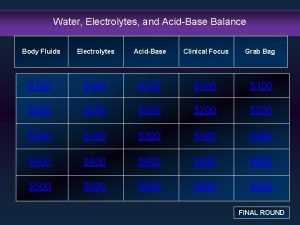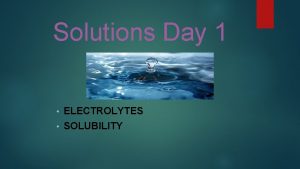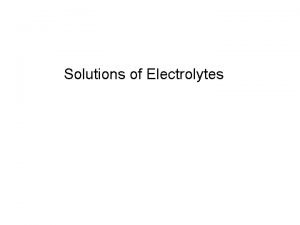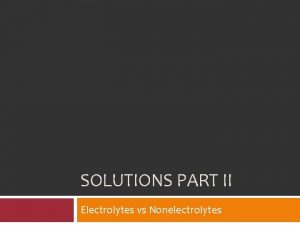Complete Ionic Equation Net Ionic Equations Electrolytes from

























- Slides: 25

Complete Ionic Equation Net Ionic Equations

Electrolytes from Conductivity Test • Electrolytes are substances whose aqueous solution is a conductor of electricity • All electrolyte have ions dissolved in water Conductor of electricity? • Pure water: No! No ions are present • Table salt (Na. Cl) solution: Yes! Na+ & Cl 2

Dissociation • Dissociation: When ionic compounds dissolve in water, the anions and cations are separated from each other - however not all ionic compounds are soluble in water! • When compounds containing polyatomic ions dissociate, the polyatomic group stays together as one ion 3

Electrolytes • Strong electrolytes: all the electrolyte molecules or formula units are separated into ions. Table salt (Na. Cl) • Non-electrolytes: none of the molecules are separated into ions. Table sugar (C 12 H 22 O 11), all gases (CO 2), water. • Weak electrolytes: a small percentage of the molecules are separated into ions. Acetic acid (Vinegar, CH 3 COOH), ammonia in water (NH 3). 4

Strong Electrolytes • Salts = water soluble ionic compounds üNa. Cl, NH 4 C 2 H 3 O 2, Ba(NO 3)2, Fe. Br 3, Cu. SO 4 • Strong Acids = completely dissociate to form H+ ions in water solution. üHCl, HBr, HI, HNO 3, H 2 SO 4, HCl. O 4 • Strong Bases = water soluble metal hydroxides (OH-) ü Metal hydroxide of ALL GIA metals such as Na. OH, KOH, etc. üLower GIIA hydroxides: Ca(OH)2), Sr(OH)2, Ba(OH)2 5

Dissociation • Potassium iodide dissociates in water into potassium cations and iodide anions KI(aq) K+(aq) + I-(aq) K I K+ I- • Copper(II) sulfate dissociates in water into copper(II) cations and sulfate anions Cu. SO 4(aq) Cu 2+(aq) + SO 42 -(aq) Cu SO 4 Cu 2+ SO 426

Dissociation involving Polyatomic Ions • Ammonium phosphate dissociates in water into ammonium cations and phosphate anions (NH 4)3 PO 4(aq) 3 NH 4+(aq) + PO 43 -(aq) NH 4 PO 4 NH 4+ PO 43 - NH 4+ 7

Ionic Equations • Molecular equations uses Chemical formulas 2 KOH(aq) + Mg(NO 3)2(aq) ® 2 KNO 3(aq) + Mg(OH)2(s) • Ionic equations describe the material’s structure when dissolved. ü ONLY aqueous strong electrolytes are written as ions Ø soluble salts, strong acids, strong bases ü ALL OTHER compounds, Gases, Solids (such as insoluble substances), Liquids are written in molecular form 2 K+(aq) + 2 OH−(aq) + Mg 2+(aq) + 2 NO 3−(aq) ® 2 K+(aq) + 2 NO 3−(aq) + Mg(OH)2(s) 8

Net Ionic Equations • Ions that are both reactants and products are called spectator ions 2 K+(aq) + 2 OH−(aq) + Mg 2+(aq) + 2 NO 3−(aq) ® 2 K+(aq) + 2 NO 3−(aq) + Mg(OH)2(s) Net ionic equation: An ionic equation in which the spectator ions are removed 2 OH−(aq) + Mg 2+(aq) ® Mg(OH)2(s) 9

Example: Acid-Base neutralization NOTE: ONLY soluble salts, strong acids, and strong bases forms ions 2 HNO 3(aq) + Ca(OH)2(s) ® 2 H 2 O(l) + Ca(NO 3)2(aq) Types? _____ Ionic equation: Spectator ions? net ionic equation: 10 ________

Example: Gas-forming ionic equation ONLY soluble salts, strong acids, and strong bases forms ions Na 2 CO 3(aq) + 2 HCl(aq) ® 2 Na. Cl(aq) + CO 2(g) + H 2 O(l) Types? ________ Ionic equation: Spectator ions? net ionic equation: 11 ____

Precipitation Reaction as ionic equation ONLY _____, ______, and ______ forms ions!!! K 2 CO 3(aq) + 2 Ag. NO 3(aq) ® 2 KNO 3(aq) + Ag 2 CO 3(s) Types? ________ Ionic equation: Spectator ions? net ionic equation: 12 ___________

More Practice – Write the ionic and net ionic equation K 2 SO 3(aq) + 2 HBr(aq) ® H 2 O(l) + SO 2(g) + 2 KBr(aq) CO 2(g) + 2 KOH(aq) ® K 2 CO 3(aq) + H 2 O(l) Ba(OH)2(aq) + H 2 SO 4(aq) ® 2 H 2 O(l) + Ba. SO 4(s) 2 Li. OH(aq) + Cu. SO 4(aq) ® Cu(OH)2(s) + Li 2 SO 4(aq) 13

More Practice – Convert and Complete, then Write the ionic and net ionic equation chloric acid + ammonium sulfite silver acetate + iron(III) bromide zinc hydroxide + sulfuric acid lithium sulfite + manganese(II) chloride 14

Weak Electrolytes Does NOT dissociate • Weak acids (acetic acid, nitrous acid, hydrofluoric acid, etc), Weak base (ammonium hydroxide, etc), Insoluble salts largely remain undissociated in water HC 2 H 3 O 2(aq) H+(aq) + C 2 H 3 O 2 -(aq) NH 4 OH(aq) NH 4+(aq) + OH-(aq) Pb. Cl 2(s) Ca. CO 3(s) Ba. SO 4(s) • Pure gas, liquid, or solid exists as non-dissolved states CO 2(g), H 2 S(g), H 2 O(l), Al(s), Hg(s) 15

Write the ionic and net ionic equation involving weak or non-electrolyte(s) Na 2 CO 3(aq) + 2 HC 2 H 3 O 2(aq) ® 2 Na. C 2 H 3 O 2(aq) + CO 2(g) + H 2 O(l) sol. salt weak acid sol. salt nonelectrolyte 2 Na+(aq) + CO 32−(aq) + 2 HC 2 H 3 O 2(aq) ® 2 Na+(aq) + 2 C 2 H 3 O 2−(aq) + CO 2(g) + H 2 O(l) NIE: CO 32−(aq) + 2 HC 2 H 3 O 2(aq) ® 2 C 2 H 3 O 2−(aq) + CO 2(g) + H 2 O(l) 16

Write the ionic and net ionic equation involving weak or non-electrolyte(s) NH 4 OH(aq) + HC 2 H 3 O 2(aq) ® NH 4 C 2 H 3 O 2(aq) + H 2 O(l) weak base weak acid sol. salt nonelectrolyte NH 4 OH(aq) + HC 2 H 3 O 2 (aq) ® C 2 H 3 O 2−(aq) + NH 4+(aq) + H 2 O(l) NIE: no spectator ions, same as Complete Ionic Equations 17

Practice – Write the ionic and net ionic equation K 2 CO 3(aq) + 2 HC 2 H 3 O 2(aq) ® H 2 O(l) + CO 2(g) + 2 KC 2 H 3 O 2(aq) 2 HI(aq) + Ba. SO 3(s) ® Ba. I 2(aq) + H 2 O(l) + SO 2(g) Ba. Br 2(aq) + 2 Ag. NO 3(aq) ® 2 Ag. Br(s) + Ba(NO 3)2(aq) 2 NH 4 OH(aq) + Cu. SO 4(aq) ® Cu(OH)2(s) + (NH 4)2 SO 4(aq) 18

More Practice – Convert and Complete, then Write the ionic and net ionic equation sulfuric acid + ammonium hydroxide aluminum acetate + ammonium hydroxide iron(II) sulfite + acetic acid scandium(III) hydroxide + acetic acid 19

More Practice: Write and Balance the Ionic and Net Ionic Equation in aqueous solution from Word Equation • hydrobromic acid + zinc metal zinc bromide + hydrogen gas • chlorine gas + water hydrochloric acid + hypochlorous acid (as a weak acid) • copper + iron(III) nitrate iron(II) nitrate + copper(II) nitrate • acetic acid + magnesium metal magnesium acetate + hydrogen gas 20

Example–Ionic and net ionic equation NOTE: ONLY soluble salts, strong acids, and strong bases forms ions 2 HNO 3(aq) + Ca(OH)2(s) ® 2 H 2 O(l) + Ca(NO 3)2(aq) Forms Ions? ______ ____ Ionic equation: Spectator ions? NIE: 2 H+(aq) + Ca(OH)2(s) ® 2 H 2 O(l) + Ca 2+(aq) 21

Practice –ionic equation ONLY soluble salts, strong acids, and strong bases forms ions Na 2 CO 3(aq) + 2 HCl(aq) ® 2 Na. Cl(aq) + CO 2(g) + H 2 O(l) sol. salt sol. acid sol. salt nonelectrolyte 2 Na+(aq) + CO 32−(aq) + 2 H+(aq) + 2 Cl−(aq) ® 2 Na+(aq) + 2 Cl−(aq) + CO 2(g) + H 2 O(l) NIE: CO 32−(aq) + 2 H+(aq) ® CO 2(g) + H 2 O(l) 22

Practice – Write the ionic and net ionic equation K 2 CO 3(aq) + 2 Ag. NO 3(aq) ® 2 KNO 3(aq) + Ag 2 CO 3(s) sol. salt insoluble salt 2 K+(aq) + CO 32−(aq) + 2 Ag+(aq) + 2 NO 3−(aq) ® 2 K+(aq) + 2 NO 3−(aq) + Ag 2 CO 3(s) NIE: 2 Ag+(aq) + CO 32−(aq) ® Ag 2 CO 3(s) 23

Write the ionic and net ionic equation involving weak or non-electrolyte(s) Na 2 CO 3(aq) + 2 HC 2 H 3 O 2(aq) ® 2 Na. C 2 H 3 O 2(aq) + CO 2(g) + H 2 O(l) sol. salt weak acid sol. salt nonelectrolyte 2 Na+(aq) + CO 32−(aq) + 2 HC 2 H 3 O 2(aq) ® 2 Na+(aq) + 2 C 2 H 3 O 2−(aq) + CO 2(g) + H 2 O(l) NIE: CO 32−(aq) + 2 HC 2 H 3 O 2(aq) ® 2 C 2 H 3 O 2−(aq) + CO 2(g) + H 2 O(l) 24

Write the ionic and net ionic equation involving weak or non-electrolyte(s) NH 4 OH(aq) + HC 2 H 3 O 2(aq) ® NH 4 C 2 H 3 O 2(aq) + H 2 O(l) weak base weak acid sol. salt nonelectrolyte NH 4 OH(aq) + HC 2 H 3 O 2 (aq) ® C 2 H 3 O 2−(aq) + NH 4+(aq) + H 2 O(l) NIE: no spectator ions, same as Complete Ionic Equations 25
 Whats a net ionic equation
Whats a net ionic equation Neutralization equation
Neutralization equation Practice problems on net ionic equations
Practice problems on net ionic equations Net ionic equation
Net ionic equation Sodium carbonate + calcium chloride
Sodium carbonate + calcium chloride Net ionic equation
Net ionic equation Net ionic equation problems
Net ionic equation problems Net ionic equation definition chemistry
Net ionic equation definition chemistry Balance the equation below
Balance the equation below Net ionic equation 뜻
Net ionic equation 뜻 A net ionic equation eliminates the
A net ionic equation eliminates the Precipitation solubility rules
Precipitation solubility rules Molecular equation example
Molecular equation example Net ionic equation
Net ionic equation Net ionic equation
Net ionic equation Weak electrolytes examples
Weak electrolytes examples Deficiency of carbohydrate
Deficiency of carbohydrate Medicare enteral qualification checklist
Medicare enteral qualification checklist Strong vs weak electrolytes
Strong vs weak electrolytes Congenital adrenal hyperplasia electrolytes
Congenital adrenal hyperplasia electrolytes Rome mnemonic for acid base balance
Rome mnemonic for acid base balance Chapter 25 fluid electrolyte and acid-base balance
Chapter 25 fluid electrolyte and acid-base balance Strong vs weak electrolytes
Strong vs weak electrolytes Is sucrose soluble in water
Is sucrose soluble in water Dka and electrolytes
Dka and electrolytes How does electrolytes affects the chemical equilibria
How does electrolytes affects the chemical equilibria
